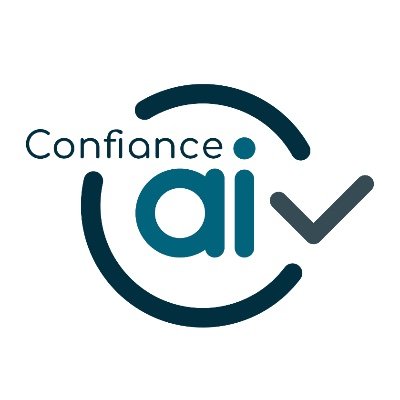MAPIE is an open-source Python library for quantifying uncertainties and controlling the risks of machine learning models. It is a scikit-learn-contrib project that allows you to:
- Easily compute conformal prediction intervals (or prediction sets) with controlled (or guaranteed) marginal coverage rate for regression [3,4,8], classification (binary and multi-class) [5-7] and time series [9].
- Easily control risks of more complex tasks such as multi-label classification, semantic segmentation in computer vision (probabilistic guarantees on recall, precision, ...) [10-12].
- Easily wrap any model (scikit-learn, tensorflow, pytorch, ...) with, if needed, a scikit-learn-compatible wrapper for the purposes just mentioned.
Here's a quick instantiation of MAPIE models for regression and classification problems related to uncertainty quantification (more details in the Quickstart section):
# Uncertainty quantification for regression problem
from mapie.regression import MapieRegressor
mapie_regressor = MapieRegressor(estimator=regressor, method='plus', cv=5)# Uncertainty quantification for classification problem
from mapie.classification import MapieClassifier
mapie_classifier = MapieClassifier(estimator=classifier, method='score', cv=5)Implemented methods in MAPIE respect three fundamental pillars:
- They are model and use case agnostic,
- They possess theoretical guarantees under minimal assumptions on the data and the model,
- They are based on peer-reviewed algorithms and respect programming standards.
MAPIE relies notably on the field of Conformal Prediction and Distribution-Free Inference.
- MAPIE runs on Python 3.7+.
- MAPIE stands on the shoulders of giants. Its only internal dependencies are scikit-learn and numpy=>1.21.
MAPIE can be installed in different ways:
$ pip install mapie # installation via `pip`
$ conda install -c conda-forge mapie # or via `conda`
$ pip install git+https://github.com/scikit-learn-contrib/MAPIE # or directly from the github repositoryHere we propose two basic uncertainty quantification problems for regression and classification tasks with scikit-learn.
As MAPIE is compatible with the standard scikit-learn API, you can see that with just these few lines of code:
- How easy it is to wrap your favorite scikit-learn-compatible model around your model.
- How easy it is to follow the standard sequential
fitandpredictprocess like any scikit-learn estimator.
# Uncertainty quantification for regression problem
import numpy as np
from sklearn.linear_model import LinearRegression
from sklearn.datasets import make_regression
from sklearn.model_selection import train_test_split
from mapie.regression import MapieRegressor
X, y = make_regression(n_samples=500, n_features=1)
X_train, X_test, y_train, y_test = train_test_split(X, y, test_size=0.5)
regressor = LinearRegression()
mapie_regressor = MapieRegressor(estimator=regressor, method='plus', cv=5)
mapie_regressor = mapie_regressor.fit(X_train, y_train)
y_pred, y_pis = mapie_regressor.predict(X_test, alpha=[0.05, 0.32])# Uncertainty quantification for classification problem
import numpy as np
from sklearn.linear_model import LogisticRegression
from sklearn.datasets import make_blobs
from sklearn.model_selection import train_test_split
from mapie.classification import MapieClassifier
X, y = make_blobs(n_samples=500, n_features=2, centers=3)
X_train, X_test, y_train, y_test = train_test_split(X, y, test_size=0.5)
classifier = LogisticRegression()
mapie_classifier = MapieClassifier(estimator=classifier, method='score', cv=5)
mapie_classifier = mapie_classifier.fit(X_train, y_train)
y_pred, y_pis = mapie_classifier.predict(X_test, alpha=[0.05, 0.32])The full documentation can be found on this link.
You are welcome to propose and contribute new ideas. We encourage you to open an issue so that we can align on the work to be done. It is generally a good idea to have a quick discussion before opening a pull request that is potentially out-of-scope. For more information on the contribution process, please go here.
MAPIE has been developed through a collaboration between Quantmetry, Michelin, ENS Paris-Saclay, and with the financial support from Région Ile de France and Confiance.ai.
[1] Vovk, Vladimir, Alexander Gammerman, and Glenn Shafer. Algorithmic Learning in a Random World. Springer Nature, 2022.
[2] Angelopoulos, Anastasios N., and Stephen Bates. "Conformal prediction: A gentle introduction." Foundations and Trends® in Machine Learning 16.4 (2023): 494-591.
[3] Rina Foygel Barber, Emmanuel J. Candès, Aaditya Ramdas, and Ryan J. Tibshirani. "Predictive inference with the jackknife+." Ann. Statist., 49(1):486–507, (2021).
[4] Kim, Byol, Chen Xu, and Rina Barber. "Predictive inference is free with the jackknife+-after-bootstrap." Advances in Neural Information Processing Systems 33 (2020): 4138-4149.
[5] Sadinle, Mauricio, Jing Lei, and Larry Wasserman. "Least ambiguous set-valued classifiers with bounded error levels." Journal of the American Statistical Association 114.525 (2019): 223-234.
[6] Romano, Yaniv, Matteo Sesia, and Emmanuel Candes. "Classification with valid and adaptive coverage." Advances in Neural Information Processing Systems 33 (2020): 3581-3591.
[7] Angelopoulos, Anastasios, et al. "Uncertainty sets for image classifiers using conformal prediction." International Conference on Learning Representations (2021).
[8] Romano, Yaniv, Evan Patterson, and Emmanuel Candes. "Conformalized quantile regression." Advances in neural information processing systems 32 (2019).
[9] Xu, Chen, and Yao Xie. "Conformal prediction interval for dynamic time-series." International Conference on Machine Learning. PMLR, (2021).
[10] Bates, Stephen, et al. "Distribution-free, risk-controlling prediction sets." Journal of the ACM (JACM) 68.6 (2021): 1-34.
[11] Angelopoulos, Anastasios N., Stephen, Bates, Adam, Fisch, Lihua, Lei, and Tal, Schuster. "Conformal Risk Control." (2022).
[12] Angelopoulos, Anastasios N., Stephen, Bates, Emmanuel J. Candès, et al. "Learn Then Test: Calibrating Predictive Algorithms to Achieve Risk Control." (2022).
MAPIE is free and open-source software licensed under the 3-clause BSD license.










